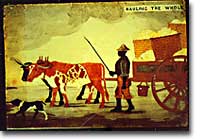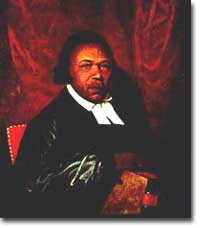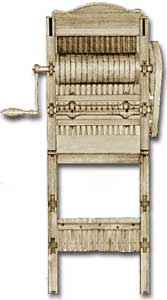22b. Cotton and African-American Life

Two-thirds of all ready-made garments, produced with southern cotton in northern cities such as New York, Boston, and Philadelphia, were sent back to the South to be worn.
The American Industrial Revolution, concentrated in the northeast, would ultimately prove to be the most significant force in the development of the modern United States. This economic innovation sprung primarily from necessity. New England's agricultural economy was the poorest in the country and that helped to spur experimentation there. Meanwhile, the far more fertile southern states remained fully committed to agriculture as the central source of its wealth, here, too, dramatic changes created a wholly new economy that would have been unrecognizable to late-18th century Americans.
The slave-based tobacco economy that sustained the Chesapeake region was in deep crisis in the late-18th century and some Virginia leaders even talked about ending slavery. But technological innovations to process cotton soon gave new life to slavery, which would flourish in the new nation as never before.

"Whereas, Absalom Jones and Richard Allen, two men of the African race, who ... from a love to the people of their complexion whom they beheld with sorrow ... propose that a society should be formed, without regard to religious tenets, provided, the persons lived an orderly and sober life, in order to support one another in sickness, and for the benefit of their widows and fatherless children." -Preamble of the Free African Society, 1778
Eli Whitney was among the first to develop a cotton gin (short for "engine") that separated seeds from short-staple cotton. This hardier cotton variety thrived in the new land of the Old Southwest, and could now be processed far more efficiently than had been possible by hand. Indeed, the gin increased by fifty times what a single person could process in a day. This new cotton production, in turn, provided the raw material for the booming industrial textile mills of the American northeast and Great Britain. Technological innovation and geographic expansion made the south the world's largest producer and exporter of cotton in the 19th century.
This economic triumph, however, was accompanied by an immeasurable human tragedy. By 1820 all of the northern states had outlawed slavery, but the rise of cotton made the enormous profits of the slave system irresistible to most white southerners. Distinctive northern and southern sections of the United States were emerging with the former more urban and industrial and the latter more agricultural, but the new economies of each section were deeply intertwined. Not only did southern cotton feed northern textile mills, but northern insurers and transporters played a major part in the growth of the modern slave economy of the cotton south.
The rise of "King Cotton" as the defining feature of southern life revitalized slavery. The promise of cotton profits encouraged a spectacular rise in the direct importation of African slaves in the years before the trans-Atlantic trade was made illegal in 1808. 250,000 new slaves arrived in the United States from 1787 to 1808, a number equal to the entire slave importation of the colonial period. After 1808, the internal slave trade forced African Americans from the border states and Chesapeake into the new cotton belt, which ultimately stretched from upcountry Georgia to eastern Texas. In fact, more than half of the Americans who moved to the Southwest after 1815 were enslaved blacks.

The cotton gin was not Eli Whitney's only contribution to the Industrial Revolution in America. He also started the first factory which used interchangable parts in manufacturing.
With a growing free black population in northern and border states, 95 percent of the country's African American population was enslaved in 1820. Generalizing about African American experience under slavery is especially difficult because the oppressive slave system all but entirely eliminated the avenues for slaves to honestly express themselves in public. There can be absolutely no doubt, however, that enslaved people rejected their status and that their constant resistance in small ways and large made white masters resort to terrifying violence in order to make the slave system work.
Enslaved people's greatest act of collective resistance lay in the constant ways that they demonstrated their humanity and challenged the legitimacy of slavery. In the face of abominable conditions, enslaved African Americans created communities that gave meaning and purpose to their lives. At the heart of black communities lay two central institutions: family and religion. Slave marriages were not legally recognized in slave societies and as many as a third of all slave marriages were broken up by masters. In spite of this, enslaved African Americans formed long-term marital bonds.
Furthermore, the severity of slave life encouraged the development of extended kin relations. Since young adults were especially likely to be sold, parents and children were frequently separated leading most slave communities to act collectively by respecting all elders and nurturing all children like one large family.
Religion also provided a major source of support to enslaved African Americans. It was only in the early 19th century that significant numbers of slaves became Christians. Partly this represents an increasing Americanization among African Americans, many of whom had now lived in the New World for several generations.
But to be a black Christian was not necessarily to have the same values as a white Christian. Slaves undoubtedly adjusted Christianity to fit their own life experiences and there is little doubt that Moses' leading the enslaved Israelites to the Promised Land had special resonance among American slaves. Black spirituals like "Didn't My Lord Deliver Daniel ... and why not every man" had similar subversive messages.







